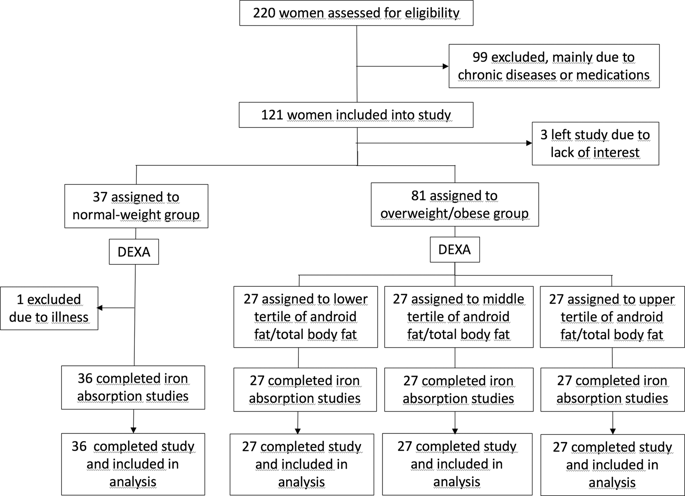当前位置:
X-MOL 学术
›
Int. J. Obesity
›
论文详情
Our official English website, www.x-mol.net, welcomes your
feedback! (Note: you will need to create a separate account there.)
The effect of central obesity on inflammation, hepcidin, and iron metabolism in young women.
International Journal of Obesity ( IF 4.2 ) Pub Date : 2020-01-23 , DOI: 10.1038/s41366-020-0522-x Nicole U Stoffel 1 , Carla El-Mallah 2 , Isabelle Herter-Aeberli 1 , Nour Bissani 2 , Nour Wehbe 2 , Omar Obeid 2 , Michael B Zimmermann 1
International Journal of Obesity ( IF 4.2 ) Pub Date : 2020-01-23 , DOI: 10.1038/s41366-020-0522-x Nicole U Stoffel 1 , Carla El-Mallah 2 , Isabelle Herter-Aeberli 1 , Nour Bissani 2 , Nour Wehbe 2 , Omar Obeid 2 , Michael B Zimmermann 1
Affiliation

|
BACKGROUND/OBJECTIVES
In overweight and obesity (OW/OB), greater total body fat predicts higher serum hepcidin (SHep) which can impair iron homeostasis and increase risk for iron deficiency (ID). However, the effect of body fat distribution on SHep and iron homeostasis is unclear. In central obesity, interleukin (IL)-6 released from visceral adipose tissue into portal blood could strongly stimulate hepatic hepcidin synthesis. Thus, our hypothesis was that higher amounts of android fat, rather than gynoid fat, would predict impaired iron metabolism in OW/OB.
SUBJECTS/METHODS
In this cross-sectional study, we enrolled 117 otherwise-healthy women into two groups: normal weight; BMI < 25 (n = 36) and OW/OB; BMI ≥ 25 (n = 81); we then subdivided the OW/OB using DEXA into tertiles based on the ratio of android fat/total body fat (AF/TBF). We measured inflammation and iron status, and assessed iron absorption in two ways: by measuring erythrocyte isotope incorporation from a labeled test meal containing 6 mg 57Fe (representing dietary iron); and by measuring change in serum iron (ΔSeFe) after a 100 mg oral iron challenge (representing supplemental iron).
RESULTS
Greater AF/TBF correlated with higher CRP, AGP, SHep, and TIBC, and lower transferrin saturation and SeFe/SHep ratio (for all, p < 0.05). Greater AF/TBF correlated with lower supplemental iron absorption (ΔSeFe) (p = 0.08) but not lower dietary iron absorption. In multiple regressions, AF/TBF positively predicted CRP (p < 0.001) and SHep (p < 0.05); a model including AF/TBF and serum ferritin as covariates explained 65% of the variance in SHep. AF/TBF negatively predicted TSAT (p < 0.05) and iron absorption (ΔSeFe) (p = 0.07). In contrast, the ratio of gynoid fat/total body fat was not significantly associated with these variables.
CONCLUSION
Body fat distribution affects iron metabolism: women with greater central adiposity have higher SHep, greater impairments in iron homeostasis, and reduced iron absorption from a supplemental iron dose.
中文翻译:

中心性肥胖对年轻女性炎症、铁调素和铁代谢的影响。
背景/目标 在超重和肥胖 (OW/OB) 中,较高的全身脂肪预示着较高的血清铁调素 (SHep),这会损害铁稳态并增加缺铁 (ID) 的风险。然而,身体脂肪分布对 SHep 和铁稳态的影响尚不清楚。在向心性肥胖中,从内脏脂肪组织释放到门静脉血中的白介素 (IL)-6 可以强烈刺激肝铁调素合成。因此,我们的假设是更多的机器人脂肪,而不是女性脂肪,可以预测 OW/OB 中铁代谢受损。对象/方法 在这项横断面研究中,我们将 117 名其他方面健康的女性分为两组:正常体重;BMI < 25 (n = 36) 和 OW/OB;BMI ≥ 25(n = 81);然后,我们使用 DEXA 将 OW/OB 细分为基于 android 脂肪/全身脂肪的比率 (AF/TBF) 的三分位数。我们测量炎症和铁状态,并通过两种方式评估铁吸收:通过测量含有 6 毫克 57Fe(代表膳食铁)的标记测试餐中的红细胞同位素掺入;并通过测量口服 100 毫克铁(代表补充铁)后血清铁 (ΔSeFe) 的变化。结果 较高的 AF/TBF 与较高的 CRP、AGP、SHep 和 TIBC 以及较低的转铁蛋白饱和度和 SeFe/SHep 比率相关(对于所有情况,p < 0.05)。较大的 AF/TBF 与较低的补充铁吸收 (ΔSeFe) (p = 0.08) 相关,但与较低的膳食铁吸收无关。在多元回归中,AF/TBF 正预测 CRP (p < 0.001) 和 SHep (p < 0.05);包括 AF/TBF 和血清铁蛋白作为协变量的模型解释了 SHep 中 65% 的变异。AF/TBF 负面预测 TSAT(p < 0。05) 和铁吸收 (ΔSeFe) (p = 0.07)。相比之下,女性脂肪/全身脂肪的比率与这些变量没有显着相关性。结论 体脂分布影响铁代谢:中央肥胖女性的 SHep 更高,铁稳态受损更大,补充铁剂量后铁吸收减少。
更新日期:2020-01-23
中文翻译:

中心性肥胖对年轻女性炎症、铁调素和铁代谢的影响。
背景/目标 在超重和肥胖 (OW/OB) 中,较高的全身脂肪预示着较高的血清铁调素 (SHep),这会损害铁稳态并增加缺铁 (ID) 的风险。然而,身体脂肪分布对 SHep 和铁稳态的影响尚不清楚。在向心性肥胖中,从内脏脂肪组织释放到门静脉血中的白介素 (IL)-6 可以强烈刺激肝铁调素合成。因此,我们的假设是更多的机器人脂肪,而不是女性脂肪,可以预测 OW/OB 中铁代谢受损。对象/方法 在这项横断面研究中,我们将 117 名其他方面健康的女性分为两组:正常体重;BMI < 25 (n = 36) 和 OW/OB;BMI ≥ 25(n = 81);然后,我们使用 DEXA 将 OW/OB 细分为基于 android 脂肪/全身脂肪的比率 (AF/TBF) 的三分位数。我们测量炎症和铁状态,并通过两种方式评估铁吸收:通过测量含有 6 毫克 57Fe(代表膳食铁)的标记测试餐中的红细胞同位素掺入;并通过测量口服 100 毫克铁(代表补充铁)后血清铁 (ΔSeFe) 的变化。结果 较高的 AF/TBF 与较高的 CRP、AGP、SHep 和 TIBC 以及较低的转铁蛋白饱和度和 SeFe/SHep 比率相关(对于所有情况,p < 0.05)。较大的 AF/TBF 与较低的补充铁吸收 (ΔSeFe) (p = 0.08) 相关,但与较低的膳食铁吸收无关。在多元回归中,AF/TBF 正预测 CRP (p < 0.001) 和 SHep (p < 0.05);包括 AF/TBF 和血清铁蛋白作为协变量的模型解释了 SHep 中 65% 的变异。AF/TBF 负面预测 TSAT(p < 0。05) 和铁吸收 (ΔSeFe) (p = 0.07)。相比之下,女性脂肪/全身脂肪的比率与这些变量没有显着相关性。结论 体脂分布影响铁代谢:中央肥胖女性的 SHep 更高,铁稳态受损更大,补充铁剂量后铁吸收减少。









































 京公网安备 11010802027423号
京公网安备 11010802027423号